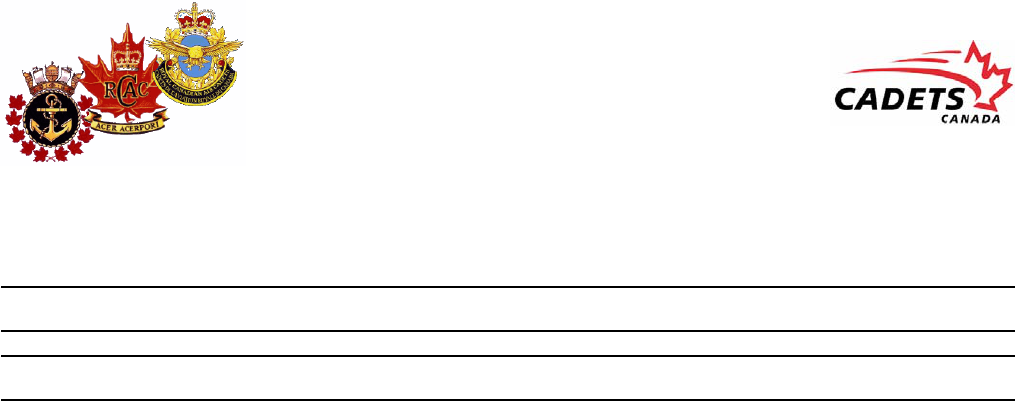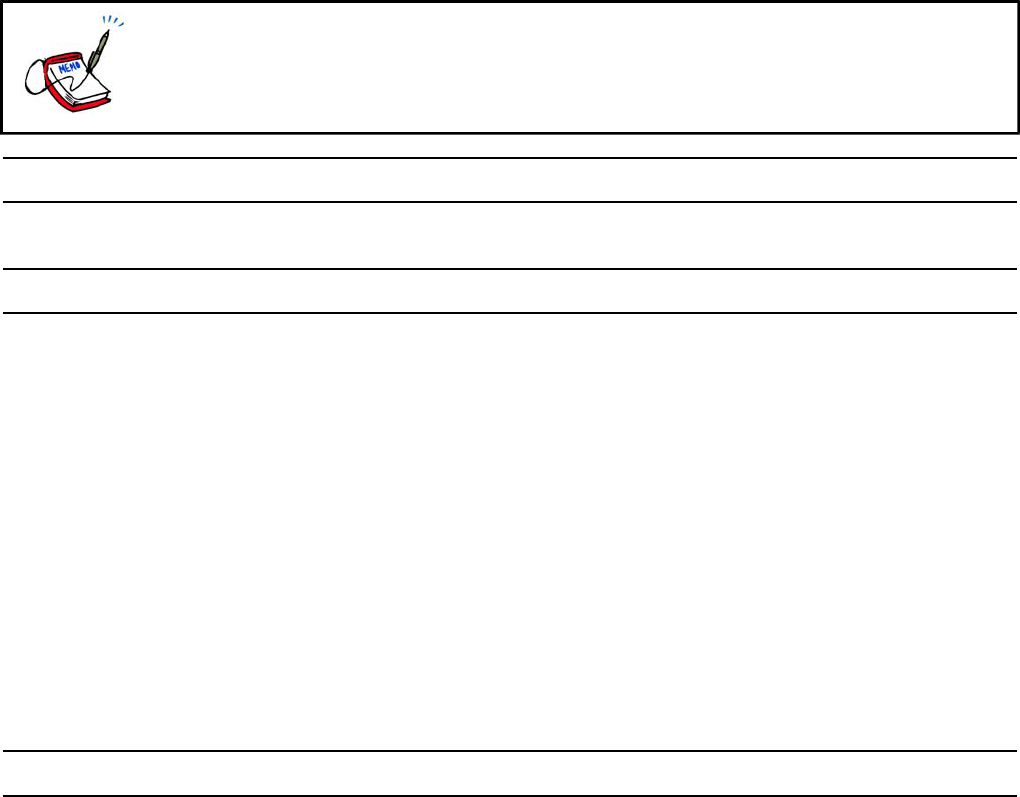
A-CR-CCP-801/PF-001
4-2-1
COMMON TRAINING
INSTRUCTIONAL GUIDE
SECTION 2
EO M104.02 – DEVELOP A PERSONAL ACTIVITY PLAN
Total Time: 30 min
INTRODUCTION
PRE-LESSON INSTRUCTIONS
A complete list of resources needed for the instruction of this EO is located at Chapter 2 of the QSP. Specific
uses for said stores are identified throughout the Instructional Guide, within the teaching point for which they
are required.
The instructor shall review the lesson content, and become familiar with the material prior to instruction of this
lesson.
PRE-LESSON ASSIGNMENT
N/A.
APPROACH
For TP1 and TP2, the interactive lecture method was chosen as it allows the instructor to make a semi-
formal presentation of the material where the cadets can participate by asking or responding to questions and
commenting on the material. For this lesson, this method is most effective as it matches well the taxonomic
level of the material and is age-appropriate by virtue of its participatory nature.
The practical activity in TP3 will verify the cadets’ understanding of the material and will allow them to apply the
knowledge acquired during the lesson. The cadets will complete the exercise under direction and supervision.
REVIEW
N/A.
OBJECTIVES
By the end of this lesson, the cadet will be expected to develop a personal activity plan.
IMPORTANCE
One of the aims of the air cadet program is physical fitness. In order to help the cadets achieve success in
physical fitness, it is important to teach them how to set personal fitness goals and create an activity plan to
help them achieve those goals.

A-CR-CCP-801/PF-001
4-2-2
Teaching Point 1 Explain How To Develop Goals
Time: 8 min Method: Interactive Lecture
DEFINITION OF A GOAL
The Canadian Oxford Dictionary defines a goal as the object of an ambition or effort, an aim.
SHORT- AND LONG-TERM GOALS
Short-term goals are smaller goals that work towards a long-term goal. For example, if your long-term goal
was to run for 3 kilometres (km) in six months, a reasonable short-term goal would be to run for 1 kilometre
in two months.
INDIVIDUAL AND TEAM GOALS
An individual can work towards achieving a goal, or a team can work towards achieving a common goal.
An individual goal is an aim or an ambition that one person strives to achieve. An individual goal is designed
around the individual’s abilities and personal expectations.
A team goal is an aim or ambition that a group of people work towards together to achieve. An example of a
team goal could be walking across their province. The team would make a commitment to walk a predetermined
amount of kilometres in a certain period of time. The team would keep track how many kilometres they have
walked on their own and record their progress together on a map. As soon as the kilometres add up to the
correct amount, the team has reached their goal.
HOW TO DEVELOP GOALS
Cadets should set a specific goal to work toward. The acronym SMART is a tool the cadets may find useful. The
“S” of SMART stands for specific: the aim of the goal must be precisely defined. “M” stands for measurement:
identify a standard with which to assess achievement. “A” stands for achievable: ensure needed resources
are accessible for accomplishing the goal. “R” stands for relevant: ensure the goal is worthwhile for the cadet.
“T” is for timing which represents the completion date of the goal. Ask the following questions to the cadets
to help elicit SMART goals:
Specific. What specific activity can you do to help you reach your goal? Your goal should be concise and
focused on one specific outcome (your goal cannot be too vague).
Measurable. How will you measure the achievement of the goal? What will you feel when the goal is achieved?
Achievable. What might hinder you as you progress toward the goal? What resources can you call upon?
Relevant. What will you get out of this?
Timing. When will you achieve this goal? What will be your first step?
CONFIRMATION OF TEACHING POINT 1
QUESTIONS
Q1. What is the difference between short- and long-term goals?
Q2. Explain individual and team goals.
Q3. What does “SMART” stand for?

A-CR-CCP-801/PF-001
4-2-3
ANTICIPATED ANSWERS
A1. Short-term goals are smaller goals that work towards a long-term goal.
A2. An individual can work towards achieving a goal, or a team can work towards achieving a common goal.
A3. Specific, Measurable, Achievable, Relevant, Timing.
Teaching Point 2 Explain How To Create a Personal Activity Plan
Time: 8 min Method: Interactive Lecture
CREATE AN ACTIVITY PLAN
Getting started is the hardest part. Creating an activity plan will help the cadet maintain focus and succeed at
achieving set goals. An activity plan should meet the following criteria:
Activities That Will Help Achieve Set Goals. It is important to choose activities that will help the cadet achieve
the goal(s) they have set for themselves. For instance, if the goal is to improve cardiovascular fitness, an
appropriate activity would be one that builds up cardio stamina, e.g. start off running for one minute, then
walking for one minute, and try working up to running for 10 minutes.
Moderate Activities and Vigorous Activities. Moderate activities would include activities like brisk walking,
skating and biking. Vigorous activities would include running, weight training, basketball or soccer.
Fitting Your Lifestyle. Cadets should participate in activities at least once a week that fit their lifestyle. Activities
that do not fit into their lifestyle will be difficult to carry out.
Simple Activities. Choosing simple activities that can be done with little planning will most likely carry the best
results. When activities require a great deal of planning, it can become more of a chore than an activity or may
become too difficult to follow through with.
CONFIRMATION OF TEACHING POINT 2
QUESTIONS
Q1. What are the two types of activities to choose from?
Q2. What things should be considered when creating an activity plan?
ANTICIPATED ANSWERS
A1. Vigorous and moderate activities.
A2. Consider simple activities that will fit your lifestyle, and that will help achieve the goals that you have
set for yourself.
Teaching Point 3 Have Cadets Create an Activity Plan
Time: 9 min Method: Individual Activity
CREATE AN ACTIVITY PLAN
Allow the cadets time to create their activity plans. This is to be done on an individual basis. An example of
an activity plan is located in Annex A.

A-CR-CCP-801/PF-001
4-2-4
Allow the cadets to take their plan home to work on it further if desired. It is not mandatory
that it be completed during this period.
END OF LESSON CONFIRMATION
End of lesson confirmation will take place as the cadets create their activity plans.
CONCLUSION
HOMEWORK/READING/PRACTICE
Cadets may take their plan home to work on it further if desired, as it is not mandatory that it be completed
during this period.
METHOD OF EVALUATION
There is no formal assessment of this EO.
CLOSING STATEMENT
One of the aims of the air cadet program is physical fitness. In order to help the cadets achieve success in
physical fitness, it is important to teach them how to set personal fitness goals and create an activity plan to
help them achieve those goals.
INSTRUCTOR NOTES/REMARKS
N/A.
REFERENCES
C0-019 (ISBN 0-7894-7147-7) Eaton, J., and Johnson, R. (2001). Coaching Successfully. New York:
Dorling, Kindersley.
C0-024 Barber, Katherine. (Ed.). (2001). The Canadian Oxford Dictionary. Don Mills: Oxford University
Press.
C1-011 (ISBN 0-662-32899) Minister of Health (2002). Canada’s Physical Activity Guide to Healthy Active
Living [Brochure].
